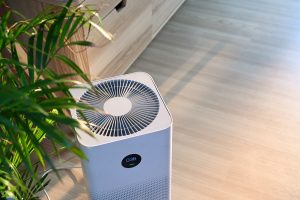How to limit your exposure to harmful chemicals at home
Advocate Aurora Healthcare News — May 21, 2022
Use of air purifiers in your home can reduce the amount of allergens and chemicals that can have negative effects on overall health.
One reality of modern life is that many of the most common substances we encounter on a daily basis can include chemicals that can be harmful to your health and damaging to our planet.
Some can cause short-term symptoms like asthma flare-ups or rashes on your skin. Others, though, can create long-term issues if you’re exposed to harmful chemicals over time, leading to diseases including cancer.
Because you likely spend a lot of time in your home, reducing your exposure to harmful chemicals in your living space is a good place to start. “Knowing what’s in your products is really essential to keeping yourself safe,” said Monica Nakielski, vice president for Environmental Affairs and Sustainability at Advocate Aurora Health. “It can be challenging, but there are a lot of resources, though, to help you.”
For starters, here are three basic areas to think about your chemical exposure that are common to everyone.
Everyone needs water, and that’s what can make potential contamination harmful.
Especially in cities with older infrastructure, lead can be an issue because it can leech into the water from older pipes made from the metal. It’s harmful to your health, especially for children.
Because lead is odorless and tasteless, the Environmental Protection Agency says the only way to know if it’s in your water is to have it tested. They offer some suggestions to do that here, starting with contacting your local water utility.
Air pollution is a clear health hazard, but the air inside your home can be harmful, too. The good news is that many of the solutions to clean the air in your home doesn’t have to cost a lot of money. Here are some ideas.
- Quit smoking or vaping indoors: If you can’t quit smoking or vaping, do everything you can to avoid exposing others to your fumes. (You of course should quit smoking outdoors, too.)
- Clean your humidifier regularly: If you have a humidifier, clean it every three days to a week to prevent bacteria and mold growth.
- Replace your HVAC filter — It’s recommended to change your HVAC filter every few months. View instructions here.
- Ventilate while cooking: Frying foods and cooking without ventilation increases indoor air pollution. Turn on your stove’s ventilation hood or open windows when cooking.
- Address mold or damp spots in your home: If you smell anything musty around your home you should investigate. Common areas for mold growth include basements, showers, and around heating and cooling appliances.
- Invest in an air purifier or plants: Some of the best plants to filter air include the Spider plant, Boston fern, Bamboo palm, Snake plant, Peace lily, and Red-edged dracaena.
- Ventilate and use green cleaners when cleaning: Many conventional cleaners contain a plethora of chemicals that can contribute to air pollution in your home. Switching to green certified cleaners, where appropriate, and ventilating while cleaning can reduce air pollution.
Another chemical that can get in the air are particles from common household cleaning products.
Nakielski suggests avoiding using chlorine and bleach-based cleaning products. Baking soda and water can help clean surfaces like counters. And you could use lemon juice and vinegar for surfaces that can be scratched, like chrome.
Above all, carefully read the directions for any product you use.







